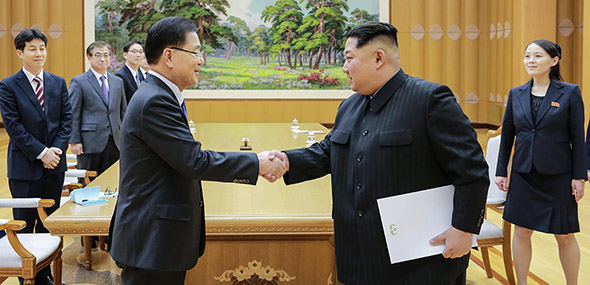ELECTION INSIGHTS 2018
Research-based perspectives from MIT
Vipin Narang | On the US / North Korean Relationship
Associate Professor of Political Science

Photo by Stuart Darsch
"The North Korean nuclear program is not something to be 'solved' — that window has closed — it is an issue to be managed. The good news is that the United States has a lot of experience managing the emergence of new nuclear weapons powers."
ELECTION INSIGHTS 2018
Research-based perspectives from MIT
QUESTION
Saber-rattling between the United States and North Korea has brought heightened attention to the threat of nuclear war. Drawing on your research and expertise on the distinctive nuclear strategies of various countries and regions, what do you see as the best way out of this particular danger zone?
COMMENTARY
The North Korean nuclear crisis has occupied much of the Trump administration’s foreign policy bandwidth since it took office, but it is now time to accept the unvarnished truth: North Korea is a nuclear weapons power, and it will not unilaterally disarm. The problem is no longer one of preventing North Korea from going nuclear, it is how to manage a nuclear North Korea.
Let's review how we got here. North Korea had been developing nuclear weapons and ballistic missile capabilities for almost a quarter of a century, but 2017 marked a dramatic sprint that saw a flurry of provocative testing activity and "fire and fury" threats. In addition to three successful tests of two different types of intercontinental ballistic missiles (ICBMs), North Korea detonated a massive purported thermonuclear device in September 2017 that dramatically announced the arrival of North Korea as a serious nuclear weapons power.
By the end of 2017, a program that was once derided as a “joke” was anything but one. Indeed, the accelerated testing schedule culminated in Chairman Kim Jong Un declaring his nuclear deterrent force “complete” by year’s end — by which he meant he now had the ability to plausibly deliver nuclear weapons against both regional targets in South Korea, Japan, and Guam as well as put the American homeland at risk if it attempted to invade the North or effect regime change. Kim’s 2017 sprint risked a major conflict, as he provocatively lofted ICBMs over Japan.
Kim's calculated risk
But Kim's completion of that effort provided him with his “treasured sword of justice” — an operational nuclear weapons force that he has ordered to be mass produced — to deter an American-led attack. In retrospect, it’s clear Kim took a calculated risk, one that is now enabling him to negotiate from a position of strength. North Korea today is a nuclear weapons power, and it is not going to unilaterally surrender its nuclear weapons.
Once Kim declared his nuclear deterrent force complete, he immediately switched gears toward a “new strategic line” and initiated a charm offensive against South Korea, China, and the United States.
This charm offensive had four aims:
- to lower the temperature in the region (which had been on the brink of war for more than a year);
- to take the air out of the so-called “maximum pressure” sanctions campaign by convincing especially China that North Korea sought a diplomatic resolution to the crisis;
- to break the alliance between the United States and South Korea by convincing Seoul that it could now pursue a peace process without the United States; and
- to be treated as an equal with America as a nuclear weapons power.
Kim's success
Kim has succeeded on all four counts: the risk of war is measurably lower, for now; the “maximum pressure” campaign has been deflated; South Korea and the United States are working at cross purposes at the moment with the former more interested in a peace process while the latter insists that North Korea unilaterally “denuclearize” before anything else; and Kim Jong Un has met the president of the United States as an equal (in Singapore in June). Kim even managed to decouple President Trump from his own administration by forging a personal relationship with him that has left Trump convinced that Kim is committed to disarmament — a view out of sync with the views held by Trump’s own advisors.

North Korean leader Kim Jong Un (center) with Chief of the National Security Office Chung Eui Yong (left) and Kim's sister Kim Yo Jong (right), at the Workers' Party of Korea in Pyongyang, March 5, 2018
"In my view, the path forward for the United States is to abandon the insistence on unilateral North Korean disarmament as a prerequisite for progress. We should be working on encouraging nuclear restraint and responsibility from North Korea. Yes, this means accepting that North Korea is a nuclear weapons power, but that is a reality that few can now deny."
Policy in disarray
American policy toward North Korea, as a result, is currently in disarray. The Trump administration insists that North Korea must unilaterally and “completely denuclearize” before making any concessions on sanctions or a peace process, but Kim has never offered to unilaterally disarm. Not once. In Singapore, Kim agreed to “work toward complete denuclearization of the Korean Peninsula” — a statement far afield from the characterization of events used by Secretary of State Mike Pompeo to this day, that North Korea (the Democratic People's Republic of Korea, or DPRK) committed to “the final, fully verified denuclearization of the DPRK as agreed to by Chairman Kim in Singapore.”
The actual declaration, and the continued North Korean formulation on “denuclearization” refers to the entirety of the Korean Peninsula and imposes corresponding obligations on the United States, such as removal of forces and strategic assets from the region. The commitment on denuclearization also follows mutual commitments on trust and peace-building, a sequence the North Koreans insisted on intentionally and for good reason, arguing that they will talk about denuclearization only after they have addressed the reason they acquired nuclear weapons in the first place: the threat posed by the United States.
As a result, the United States and North Korea are at an impasse. North Korea argues that it has taken good-faith measures to reduce the visibility of its nuclear program by self-imposing a testing moratorium. (Kim is basically saying, I am not going to give them up, but I won’t test them anymore for the time being.) North Korea has blown up the entrances to several of its nuclear testing tunnels and begun work to shutter a missile engine testing site. At the September Pyongyang Summit with President Moon Jae-in of South Korea, Kim even floated the possibility of dismantling some facilities at its main fissile material production site, Yongbyon (but make no mistake, it has others), if the United States takes some unspecified “corresponding measures.”
North Korea has not made a committment to disarm
None of this represents a commitment to disarm — and indeed, Kim is “mass producing” nuclear weapons and ballistic missiles just as he said he would at the beginning of 2018. These moves are an effort to push North Korea’s nuclear weapons into the background so they are not a political issue anymore. What Kim wants is to be treated like India and Pakistan, two other countries that acquired nuclear weapons outside of the nuclear nonproliferation treaty (NPT), but which are now accepted as de facto nuclear weapons powers.
Kim also expects the United States to make good on its promise of working toward trust-building and peace, such as by declaring an end to the Korean War. For now, the Trump administration has refused to do that until Kim first makes actual steps toward disarmament, such as providing a complete declaration of his nuclear facilities and inventory. It is unlikely he will. So we have a classic chicken and egg problem, all while Kim’s efforts have deflated the “maximum pressure” by convincing China to resume trade and energy supplies, further reducing American leverage against it. So, what now?
The best path forward: Encourage restraint
In my view, the path forward for the United States is to abandon the insistence on unilateral North Korean disarmament as a prerequisite for progress. We are pushing on the wrong door. We should be working on encouraging nuclear restraint and responsibility from North Korea — arms control measures such as caps on fissile material and ballistic missiles, and commitments not to sell or transfer sensitive nuclear technology or assets abroad. Yes, this means accepting that North Korea is a nuclear weapons power, but that is a reality that few can now deny.
The North Korean nuclear program is not something to be “solved” — that window has closed — it is an issue to be managed. The good news is that the United States has a lot of experience managing the emergence of new nuclear weapons powers, such as China, India, and Pakistan. There is no reason North Korea cannot be deterred — Kim has shown himself to be extremely rational and skilled. The United States can work with North Korea to achieve meaningful arms control objectives short of complete disarmament. A continued insistence on unilateral North Korean disarmament is a road back to the risk of war.
Suggested links
ELECTION INSIGHTS 2018
Research-based perspectives from MIT
Vipin Narang website
Department of Political Science
Security Studies Program
Book
Nuclear Strategy in the Modern Era
News Stories and Op-Eds
North Korea is a nuclear power. Get used to it.
Vipin Narang on North Korea Summits
Narang Examines Nuclear Strategy
How to Vote in Every State.
See video with info for your state — and vote!
